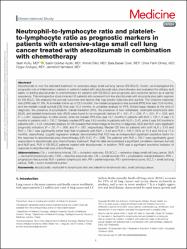Neutrophil-to-lymphocyte ratio and platelet-to-lymphocyte ratio as prognostic markers in patients with extensive-stage small cell lung cancer treated with atezolizumab in combination with chemotherapy

Göster/
Erişim
info:eu-repo/semantics/openAccessAttribution 4.0 Internationalhttps://creativecommons.org/licenses/by/4.0/Tarih
2023Yazar
Kutlu, YasinGöktaş Aydın, Sabin
Bilici, Ahmet
Öven, Bala Başak
Ölmez, Ömer Fatih
Açıkgöz, Özgür
Hamdard, Jamshid
Üst veri
Tüm öğe kaydını gösterKünye
Kutlu, Y., Göktaş Aydın, S., Bilici, A., Öven, B. B., Ölmez, Ö. F., Açıkgöz, Ö. ... Hamdard, J. (2023). Neutrophil-to-lymphocyte ratio and platelet-to-lymphocyte ratio as prognostic markers in patients with extensive-stage small cell lung cancer treated with atezolizumab in combination with chemotherapy. Medicine, 102(15), e33432-e33432. https://dx.doi.org/10.1097/MD.0000000000033432Özet
Atezolizumab is now the standard treatment for extensive-stage small cell lung cancer (ES-SCLC). Herein, we investigated the prognostic role of inflammatory markers in patients treated with atezolizumab plus chemotherapy and evaluated the efficacy and safety of adding atezolizumab to chemotherapy for patients with ES-SCLC and prognostic and predictive factors as a real-life experience. This retrospective study included 55 patients who received front-line atezolizumab with etoposide plus platin regimen for ES-SCLC. We analyzed the survival outcomes and factors that may predict response and survival. The objective response rate (ORR) was 81.8%. At a median follow-up of 23.5 months, the median progression-free survival (PFS) time was 10.8 months, and the median overall survival (OS) time was 15.2 months. In univariate analysis for PFS, limited-stage disease at the time of diagnosis, the presence of prophylactic cranial irradiation (PCI), the presence of liver metastasis, neutrophil-lymphocyte ratio (NLR), and platelet-lymphocyte ratio (PLR) were found to be prognostic factors (P = .041, P = .034, P = .031, P = .004, and P = <.001, respectively). In other words, while the median PFS time was 14.1 months in patients with PLR ≤ 135.7, it was 7.5 months in patients with > 135.7. Similarly, median PFS was 14.9 months in patients with NLR ≤ 3.43, while it was 9.6 months in patients with > 3.43. Univariate analysis for OS revealed that limited stage at the time of diagnosis, NLR and PLR were significant prognostic indicators (P = .01, P = .006, and P = .007, respectively). Median OS time for patients with both NLR ≤ 3.43 and PLR ≤ 135.7 was significantly better than that of patients with NLR > 3.43 and PLR > 135.7 (16.9 vs 11.3 and 16.9 vs 11.5 months, respectively). Logistic regression analysis demonstrated that PLR was an independent significant predictive factor for the response to atezolizumab plus chemotherapy (OR: 0.07, P = .028). The patients with PLR ≤ 135.7 were significantly good responders to atezolizumab plus chemotherapy treatment. Real-life data demonstrated a significant correlation between survival and NLR and, PLR in ES-SCLC patients treated with atezolizumab. In addition, PLR was a significant predictive indicator of response to atezolizumab plus chemotherapy.
WoS Q Kategorisi
Q3Kaynak
MedicineCilt
102Sayı
15Koleksiyonlar
- Makale Koleksiyonu [3809]
- PubMed İndeksli Yayınlar Koleksiyonu [4279]
- Scopus İndeksli Yayınlar Koleksiyonu [6642]
- WoS İndeksli Yayınlar Koleksiyonu [6717]


















